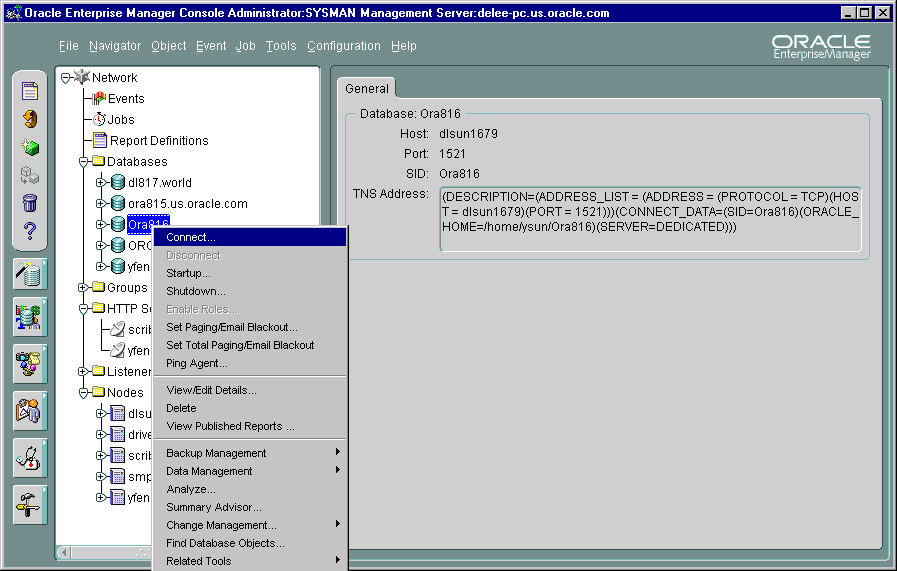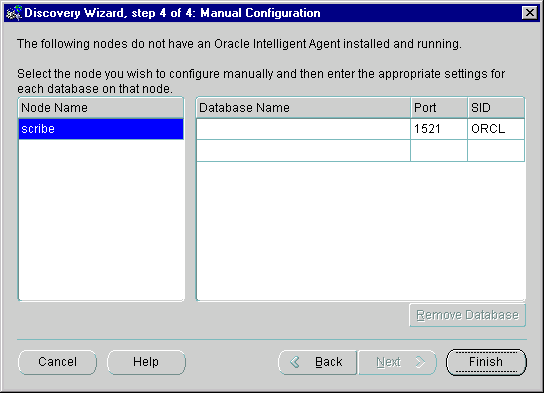Release 9.2.0
Part Number A96670-01
Home |
Book List |
Contents |
Index |
 Master Index |
 Feedback |
| Oracle Enterprise Manager Administrator's Guide Release 9.2.0 Part Number A96670-01 |
|
The Navigator graphically displays network objects and allows you to administer the objects. The Navigator tree displays a direct view of the network's nodes and services, the objects they contain, and the relationships among objects. The topics discussed in this chapter include:
The Navigator pane provides:
Because the Enterprise Manager Console uses a master/detail-type user interface, objects selected in the "master" Navigator tree control what is displayed in the "detail" pane to the right. This simple, yet effective interaction paradigm is consistent for all Enterprise Manager applications.
The Navigator tree is populated with objects by selecting Discover Nodes from the Navigator menu. The types of services in the network may include, but are not limited to:
The actual number and types of objects that appear in the Navigator differ according to the types of targets being monitored and any options you have installed in your enterprise environment.
Each object type in the Navigator tree is identified by an icon and name. If there is a '+' or '-' to the left of an object's icon and name, the object is a container that can be expanded to display other objects. A container that is represented by a folder icon is a logical grouping, or collection, of one specific type of object, such as databases. Other containers are objects that hold multiple types of objects. See Figure 3-1, "Navigator Pane and Context-sensitive Menu" for an illustration of a Navigator pane.
The top-most object in the Navigator tree is the network container. The network folder can contain:
In addition to the folders listed above, there may also be folders for additional targets that have been discovered in your enterprise.
You can expand tree containers to view the objects and relationships in the environment. For example, you can expand a node to view the databases and listeners on the node. If you expand a database, you can access common administration areas such as schema, instance, and security. When a connection is made to a database, an icon displays on the database in the tree. See "Database Administration" for more information on integrated database administration tools that are accessible from specific Navigator objects.

Text description of the illustration navig2.gif
To launch a database tool in the context of a database or database object, select the object in the Navigator tree that you want to access. You can then execute a tool from the Tools menu or with the Related Tools option of the right-mouse menu.
You are connected to the database according to the preferred credentials that have been set up for the database. If connection to the database fails for any reason, the Database Connect Information dialog box displays. At that point, you can enter the requisite information and optionally save that information as a preferred credential. See "Preferred Credentials" for information.
The Navigator menu allows you to manage objects in the Navigator pane. The menu options are enabled according to the object selected in the Navigator tree. Usually the Create, Create Like, Edit, and Remove menu options are available when an object is selected. See Figure 3-1, "Navigator Pane and Context-sensitive Menu" for an illustration of the Navigator menu.
Clicking on an object in the Navigator with the right mouse button, displays a context-sensitive menu of all the options you can use to manipulate the object, as well as related tools.
For information on operations for an object type, see the chapter in this guide that discusses the specific application that manipulates the object type. See Chapter 10, "Database Administration" for an overview of the database application tools.
Refreshes the current Navigator view.
Locates discovered databases within the Navigator Tree. It is available when you select a Database or Node icon on the tree.
Discovers services on a node in the network. You can also display the status of network services. See "Discovering Targets" for more information.
Refreshes services for all discovered nodes.
Attempts to contact the Intelligent Agent on a specified node. If it fails, either the node is down or the Intelligent Agent isn't running. If either of these is true, no Job or Event notification will come through.
Displays the Connect Information dialog allowing you to specify logon information for a selected target (such as a database) in the Navigator.
Log out of the selected target.
When viewing a database schema in the Navigator, all objects are grouped by schema.
When viewing a database schema in the Navigator, all objects are grouped by object type.
Displays the Enable Roles dialog allowing you to enable roles for an administrator.
Displays SQL statements produced by Enterprise Manager's database administration functions. This option allows you to view the last 100 SQL statements (maximum) executed by the application you are using (i.e., Instance Management, Schema Management, and others) against the selected database.
The Navigator provides service discovery functions for identifying network targets populating the Navigator tree through the Discovery Wizard. The Discovery Wizard is activated each time you select Discover Nodes from the Console's Navigator menu.

Text description of the illustration dicovery.gif
The Discovery Wizard searches the network for the targets you specify. If that target has an Oracle Intelligent Agent running, it will be added to the Enterprise Manager Console Navigator for management along with any services running on that target. You will be able use these services as targets in jobs, events, and groups.
If there is no Oracle Intelligent Agent running, the Discovery Wizard gives you the option of performing a manual configuration. This allows you to define an Oracle database on that target so that it appears in the Console Navigator. While manual configuration permits database access from the Navigator, its use is not recommended since Enterprise Manager services, such as jobs and events, will not be available. For more information on the Intelligent Agent and the discovery process, see the Oracle Intelligent Agent User's Guide.

Text description of the illustration discovma.gif
When refreshing an existing target, the Discovery Wizard verifies and updates the list of services on a target that had been previously discovered. If the target was previously Manually Configured, the Discovery Wizard will check if that target now has an Oracle Intelligent Agent and if so, provide that information with the option to discover using that Intelligent Agent, or to update the previous configuration.
|
Note: Services on the machine where the Management Server is running are automatically discovered when you start the Console and connect to the Management Server. |
To discover new services, choose Discover Nodes from the Console Navigator menu to call up the Discovery Wizard. Any services running on that target will, if successfully discovered, appear in the Navigator. The Discovery Wizard guides you through the service discovery process. For more information on service discovery and refresh, refer to Oracle Enterprise Manager online help.
Refreshing a target verifies and updates the list of services on a target that has been previously discovered. You can refresh the discovery of a target by selecting a target from the Navigator, clicking the right mouse button, and choosing Refresh Node from the context-sensitive menu.
To refresh an existing service, choose Refresh Nodes from the Console Navigator menu to call up the Refresh Wizard. The Refresh Wizard performs a "rediscovery" of any target selected in the Console Navigator. This menu option is greyed out until a specific target is selected from the Navigator Nodes folder.
Select a target from the Console Navigator. Using the right-mouse button, choose Delete from the context-sensitive menu.
Pinging the Intelligent Agent on a monitored node allows you to check whether the Management Server can communicate with the Intelligent Agent on a monitored node. Proper Intelligent Agent operation is required for successful service discovery. If discovery is successful, the discovered node and services appear in the Navigator tree. If discovery has failed, an error message displays.
The following are common problems if the service discovery has failed:
Since Enterprise Manager allows you to manage a heterogeneous environment, there will be situations where you may need to determine operational properties of that node (network name, operating system and version, and Intelligent Agent version). For example, you may want to find out which version of the Intelligent Agent is running on each node within your enterprise to determine which nodes require Intelligent Agent updates. To determine node properties, select the desired node from the Nodes folder in the Navigator. Pertinent node information is displayed in the detail pane of the Console.
The Navigator interface provides easy manipulation of the services and objects in your managed network from the Enterprise Manager Console. From the Navigator, you can apply some or all functions available from the Console and any integrated applications to selected objects.
To administer an object, select the object in the Navigator tree and choose the administration task from the Navigator menu, or use the menu options available when you click the right mouse button on the object. The menu options available vary according to the object selected. See "Navigator Menu" for more information. When you create or edit an object, the property sheet for that object displays. For information on the property sheets, see the chapter on the DBA tool that administers the object.
You can drag and drop some objects in the navigator to make copies of the object in different locations. For example, you can drag and drop a database user or role from one database to another to add that user or role to another user. However, if you drag and drop a group that resides within another group to a different group, it will move the group instead of copying it.
Before removing a discovered node from the Enterprise Manager Navigator, you must remove all jobs and events submitted against that node. If the Intelligent Agent is down when you attempt to remove the node, and jobs and events have not been cleared previously, Enterprise Manager will allow you to remove the node. However, when the Intelligent Agent is restarted and the node re-discovered, the Intelligent Agent will be out of sync with the Oracle Management Server. The following example illustrates how this situation can occur.
The Intelligent Agent remembers the current status of jobs and events through a series of generated files. Oracle Intelligent Agents 8.0.6 and higher and Intelligent Agents 8.1.6 and higher automatically synchronize with the Oracle Management Server by removing old Intelligent Agent overhead files. For older versions of the Intelligent Agent, you must remove these files manually.
To manually remove the Intelligent Agent overhead files:
Typically, node removal from the Navigator fails because of problems encountered by the Management Server. The following are the most probable causes.
The solution is to run the Management Server on the machine from which you last discovered the node. In the example above, you would need to run the Management Server on the second machine (resolved the node as "B") and then remove the node from the Navigator. Always ensure that the DNS setup is consistent for all nodes where the Management Server is run.
|
 Copyright © 1996, 2002 Oracle Corporation. All Rights Reserved. |
|